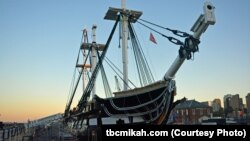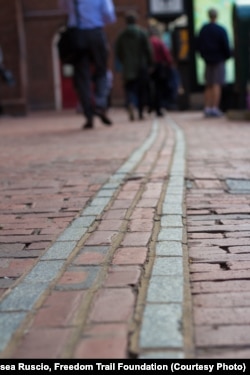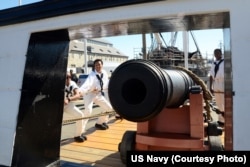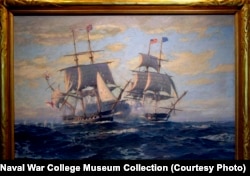As national parks traveler Mikah Meyer continues his adventures in the northeastern region of the United States, he had an opportunity to visit several national park sites in and around the historic Boston area. It was an optimal time for him to visit the region with its colorful autumn foliage and crisp fall air.
Cradle of Liberty
Boston is Massachusetts' capital and largest city. Founded in 1630, it’s one of the oldest cities in the U.S. and the site of the first major battle of the American Revolution. Its rich history is reflected in many historic sites and buildings, including churches, museums and meeting houses.
Boston National Historical Park
Boston National Historical Park sprawls across 17 hectares (43 acres) of the city, encompassing over 350 years of history. Many of the sites within it are associated with the beginnings of the American Revolution.
Meyer said his visit there was one of the highlights of his trip. He enjoyed strolling along the red-brick path of the Freedom Trail, an almost four-kilometer (2.5-mile) walking route of 16 historic sites that tells the story of the nation’s founding.
“It was fascinating,” Meyer said, “in the sense that this was almost 250 years ago, to see the country that we live in now and how it came from those roots … to see the ideals of the people that settled America and colonized it, and how those ideals reflect in the country today.”
American Patriots
Visitors can also find a wealth of historic sites, structures, and landscapes associated with the opening battle of the American Revolutionary War at Minute Man National Historical Park in Concord.
“It essentially tells the story of Paul Revere and [William Dawes], who rode from downtown Boston all the way out to Concord, Massachusetts, to warn the local townspeople that the British were approaching and were going to come and try to confiscate a stockpile of arms that the colonists had,” Meyer explained.
But the focus of the park is an eight-kilometer stretch of road, where 11 houses that were around at the time of the battle still exist today.
The shot heard around the world
It was the people in those homes who witnessed what's been called the “shot heard around the world.” Not only was that the first official shot of the Revolutionary War, Meyer noted, it was the first official death for both the British and the Americans.
“Following that, the British retreated all the way back to Boston and by now all the town people from all around the area had heard that there was this fight going on, so they all grabbed their arms and basically were shooting at the British the entire time they were marched back to the city.”
Minutemen in Colonial America
Those “citizen soldiers” came to be known as Minutemen.
"One of the statues that I took a picture with apparently is now the symbol of the National Guard,” Meyer said, “which makes sense because Minuteman basically refers to these regular citizens — they were farmers, they were businessmen — who were called in the middle of the night at a minute's notice to wake up and come and take up arms to defend their colony — to defend their people.”
"So it's this idea of the citizen soldier who started the American Revolutionary War."
Visiting the many sites along the Freedom Trail “was just a really great way to feel like you're literally walking the steps of history,” Meyer said, “because you are walking around downtown Boston and even though it's modern, it takes you to these sites that used to be the modern city for our early colonialists.”
USS Constitution — America’s Ship of State
The historic trail ends near Boston Harbor, where one of the U.S. Navy’s most famous warships is being restored.
The wooden-hulled, three-masted USS Constitution was launched on Oct. 21, 1797. It was one of six frigates commissioned during President George Washington’s administration to protect the young nation's maritime commerce. Operated by the U.S. Navy in cooperation with the National Park Service, the USS Constitution is the world's oldest commissioned warship still afloat.
Meyer got to see the ship where it's been in dry dock at the Charlestown Navy Yard since May 18, 2015 ,for a three-year restoration.
“So the [ship] right now is being refurbished — there are original pieces still on it, but they basically have lifted it out of the water right now… once they finish, they will put it back into the water,” he said.
Before restoration began, one of her cannons was fired twice a day as part of a demonstration to show visitors how the guns were loaded and fired during battle.
Meyer had an opportunity to watch a similar demonstration on a wharf off Boston Harbor, a short distance from the Constitution. The morning and evening gunfire are salutes; part of the daily flag raising and lowering ceremonies that the U.S. Navy conducts on every ship and every naval base.
“I guess I was about eight to 10 feet away, and the wind blowback from that cannon, you could feel it across my entire body,” he said. “It was an interesting feeling because you realized how much power this ancient gun had.”
Old Ironsides
The cannon's noise made Meyer think about his visit last month to Perry's Victory and International Peace Memorial in Put-In-Bay, Ohio. That site commemorates the Battle of Lake Erie which took place near Ohio's South Bass Island during the War of 1812. It was here that Commodore Oliver Hazard Perry led an American fleet to victory against the British Royal Navy.
“It totally made the experience of being at Perry's Victory and International Peace Memorial that much more poignant," Meyer said, “because it was during that battle they said that basically anyone on any of the ships was deaf for an entire year from all the cannon noise … so being that close and experiencing it, I can understand why.”
While she wasn’t at Lake Erie, the USS Constitution played a huge role in another battle of the war.
On Aug. 19, 1812, she went into action against the British frigate HMS Guerrier. Cannonballs bounced harmlessly off her side, reportedly causing a crewman to shout, “Huzzah! Her sides are made of iron!” The Constitution has been known as “Old Ironsides” ever since. After a fierce battle, the Guerrier surrendered, and the victory greatly boosted Americans' wartime morale.
Meyer said his experiences in and around one of America’s oldest cities — on the historic Freedom Trail, in the Minute Man National Historical Park, and at the side of the USS Constitution — made history come alive for him.
Follow Mikah
To follow Mikah and learn more about the places he’s traveling to, he invites you to visit him on his website.
















